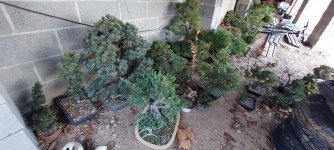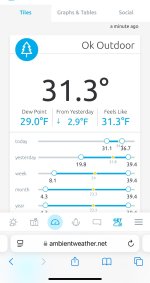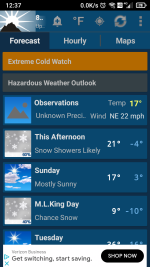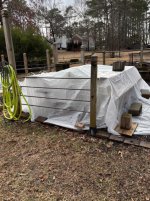I only have native conifers and not really. Dormancy is triggered by daylight and lowered temperatures. Had lengthy discussions with the professional artists and collectors and the consensus is that as long as it stays below 50F(ideally below 40F) with the shorter daylight, dormancy will occur. My target has been between 34-40F for the last 3 winters with a goal of no freeze-thaw cycles and protection against the wind. There are a few raw yamadori(native conifers) in large recovery boxes that are outside(it’s in a shielded forested area) that I mulched in. Those have definitely froze and have remained frozen.
A couple thoughts on this thread… just my experience of course..
First off, imho the best position to put the heater thermostat is on the floor, set above freezing, but a 24/7 monitoring device would best be at about 4’ in an 8x6 greenhouse… likely similar for larger ones. Good internal ventilation 24/7 should give proper mixing. This set up will allow the trees to accumulate required accumulated chill hours as rapidly as possible.
On the above comment, perhaps so, yet not so sure about that at all.
Did an awful lot of reading of scientific research before writing up and posting the wintering over resourc here. Nowhere in any paper, or review article was 50F mentioned as a temperature where our trees would accumulate chilling hours, or maintain dormancy. The highest temperature for accumulating chill hours in dormancy for any tree mentioned was 46F. (If I recall correctly that wasn’t a mainline bonsai tree either) 42F is a frequent number mentioned,
All of the studies were about trees used in forestry, few were mainline bonsai trees.
That said, research shows trees do not have to continuously maintain these temperatures. Trees can either be above, say 45F as a round number, or below 32F, but at these temperatures, at least in the general chilling hour model, a tree will not accumulate chill hours. (Models differ from full credit for any hour in the zone to partial credit at higher temps in the upper part of the zone. All are generalizations.)
Whether trees at extended temperatures above the zone will remain in dormancy is an entirely different question.
What a tree can’t do above 45F without potential negative consequences is break dormancy. But breaking dormancy takes time… from the research I did as little as a couple days to over 4 days (depends upon the species) of continuous higher temperatures to do so.
Yet in my limited experience of 7 years of bonsai work, it might take temperatures above 50F (likely more) of continuous temperature to break dormancy for most bonsai trees. But nowhere in the research is this mentioned. Practically if a tree remained at or above 50F for an extended period of time ones trees could break dormancy.
On the other hand, in our area sometimes the temperatures shoot up to the high 50’s mid 60’s during the day, only to drop down to the high 30’s, low 40’s at night without negative consequences.
Exceptions are the “tender or bridge bonsai in pots”, I.e. those plants that can’t tolerate extended periods of hard freezes). For example: many Satsuki, Chilean Myrtle’s, some quinces etc etc.. These can break dormancy for sure at a lower temperature. (Personal observation). On the flip side, most of these species have a lower chilling hour requirement compared to maples, conifers etc.
Just some thoughts.
Cheers
DSD sends


















